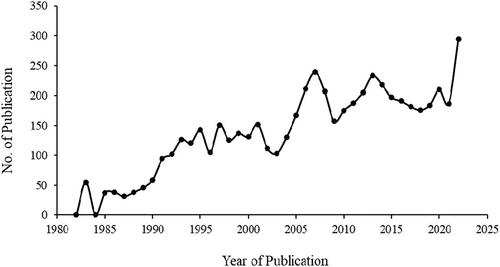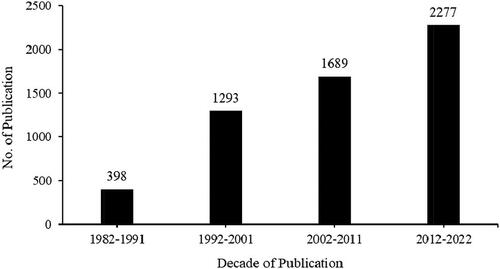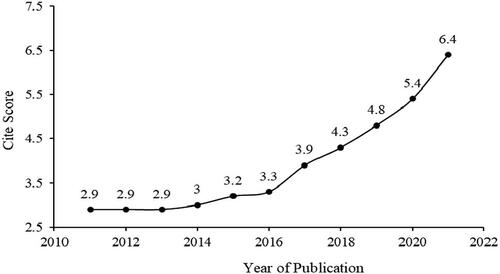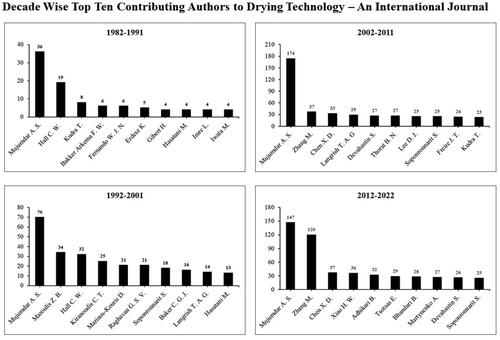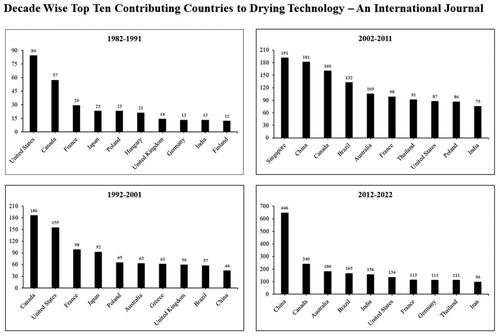On the occasion of the successful completion of its forty years of continuous publication, we are pleased to provide in this Guest Editorial a concise historical perspective of the invaluable role Drying Technology - An International Journal (LDRT) has played in the sustained dissemination of original contributions to advancing the global knowledge base in drying science, engineering and technology. Prior to the establishment of the International Drying Symposium (IDS) series in 1978 by Professor Arun Mujumdar at McGill University, Montreal, Canada, there was precious little scientific literature of archival value that appeared in the English language. It was, therefore, essential to develop a truly global forum and provide opportunities for the exchange of the latest knowledge on drying and disseminate it widely to encourage international cooperation in research and networking. Of course, without the advanced infrastructure for global travel and communication, it was a hugely daunting task to organize conferences like IDS in the 70’s and even 80’s. The success of the IDS series led to Mr. Bill Begell, President of Hemisphere Publishing Corporation, Washington DC, USA, to invite Prof. Mujumdar to edit a book series entitled Advances in Drying. The first volume in this series of 5 volumes was published in 1980. The proceedings of the biennial IDS series published during 1978–1994 were the premier and indeed the only sources of archival literature in drying during those days.
It was Dr. Maurits Dekker, the Chairman of Marcel Dekker, NY, USA, who had the vision to foresee the future of industrial drying technologies and the underlying sciences. Chairman Maurits, as he used to like calling himself, invited Prof. Mujumdar to edit the now famous Handbook of Industrial Drying in 1981 and also a journal devoted to drying technology. Prof. Mujumdar accepted the former, resulting in the first edition appearing in 1984 with international authorship. However, Prof. Mujumdar believed the time was still not ripe to sustain a journal due to the limited number of researchers in drying and, of course, a core of expert reviewers at that time. He was also overly busy as a junior faculty member at McGill University with teaching, research and academic service, while organizing the IDS series and editing the Handbook, the Advances in Drying series, as well as the new book series entitled Advances in Transport Processes; the latter culminated in 12 volumes. He recommended holding off on this journal for a few more years unless someone else could assume the primary responsibility and gratefully declined the invitation.
It is noteworthy that Chairman Maurits had the vision and strong faith in his idea and succeeded in enlisting Dr. Carl W. Hall of the National Science Foundation to accept the invitation to start this journal as the Editor-in-Chief in 1982. Dr. Hall promptly invited Prof. Mujumdar to assist him and to develop the Editorial Board and seek authors internationally based on his close contacts through the organization of three highly successful IDS events. Prof. Mujumdar then assisted with finding reviewers, while reviewing almost all the papers himself; this included revising and rewriting full papers and even getting them retyped in the special format of the journal as the journal, for over a decade, was produced from camera-ready manuscripts. This task was at least an order of magnitude harder and more time-consuming than what most researchers/readers experience now! Prof. Sakamon Devahastin started assisting with the journal over two decades ago, while still doing his PhD under the mentorship of Prof. Mujumdar at McGill University. It is noteworthy that a large fraction of the editorial team that has contributed to this journal has been Prof. Mujumdar’s students, mentees or research collaborators. The rest is history. In 1988, after the retirement of Dr. Hall from NSF, Prof. Mujumdar took over as the second Editor-in-Chief. It was a formidable task to run the journal while the field of drying was still developing and no financial or human resources were available to run an archival journal.
Readers and authors of this journal are likely not familiar with the details of this journal’s history; this information is available elsewhere. Here, we will try to focus on some of the key statistical aspects of the journal’s passage of 40 years of service. We hope this will demonstrate the sustained impact of the journal has had on academic as well as industrial drying R&D over the past four decades on a global scale. It is especially noteworthy that the journal covers academia and almost all major industrial sectors. With this guest editorial, an attempt has been made to glimpse into the history and remarkably unique journey of the journal from its year of establishment, 1982, through 2022. The historical achievements are discussed hereunder with matrices based on the database reported by Scopus as of the end of November 2022.
The year-wise number of papers published in Drying Technology is displayed in . After the establishment of the journal in 1982, only 55 articles were published in 1983, while in 2022 publication count has reached 294, fewer than one-third of the submissions. From its year of establishment, the journal has played a crucial role in nurturing multidisciplinary research that has truly imprinted its impact in the industrial revolution, especially in advancing drying technologies in several industrial sectors, e.g., pulp and paper, textile, chemical, pharmaceutical and food industries.
The decade-wise number of publications in this journal is shown in . It shows the publications and research activities that have been continuously enhanced. The Citescore of the journal is shown in ; the value increased from 2.9 to 6.4 during the decade 2011 to 2021. Clearly, the quality of papers that appear in this journal has been on the rise.
The decade-wise contributions of authors to Drying Technology are shown in . Prof. Mujumdar’s Transport Processes Research Group played a significant role in its contribution over the entire lifespan of the journal. Decade-wise distribution of the contributions from the top ten countries is plotted in . It shows that the collaboration of the Transport Processes Research Group with young as well as seasoned researchers from different countries has positively influenced the publication matrices in terms of the top ten contributing countries for publications.
t is not surprising that there has been a significant change in the R&D effort in drying in various countries. China started to make a notable contribution to the journal two decades ago and is now the major contributor to the journal. It is also clear that globalization has been an essential hallmark of the journal, as well as of IDS. Indeed, without the sustained and deliberate effort of Prof. Mujumdar, it is unlikely this journal would have achieved its premier status with authors from nearly 100 countries since its establishment.
Finally, we appreciate this opportunity to present a concise summary of the historical background and current status of the journal using standard bibliometric metrics. We acknowledge the assistance of Prof. Mujumdar in providing his thoughts and ideas on the early years of the journal. Such information would be new to most of our authors, reviewers, readers, and possibly most of the current editorial team members as well.
Institute of Chemical Technology Mumbai, ICT-IOC Odisha Campus, Bhubaneswar, India
[email protected]
Aparupa Pani http://orcid.org/0000-0002-1457-2152
Kalinga Institute of Industrial Technology, Bhubaneswar, India
[email protected]

